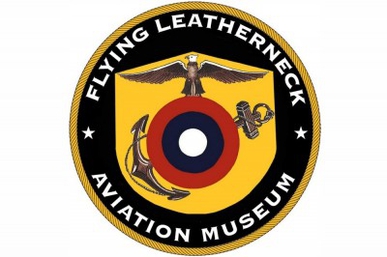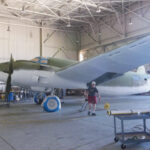By Adam Estes
While there are many museums dedicated to the history of military aviation across the United States, only one, the Flying Leatherneck Aviation Museum based at Marine Corps Air Station (MCAS) Miramar, California, can claim to be the sole museum dedicated to the preservation of aircraft and artifacts associated with the air arm of the United States Marine Corps. Unfortunately for Marine veterans and the general public alike, the museum had to close its Miramar location on March 28, 2021 due to budget cuts to the Corps, but thanks to the museum foundation’s tireless efforts and widespread public support, the Flying Leatherneck Aviation Museum is set to return to its roots at the former site of MCAS El Toro in Irvine.
The story of the Flying Leatherneck Aviation Museum begins in 1989, when Brigadier General David V. Shuter, commanding general of MCAS El Toro in Irvine, California, proposed the idea of establishing a museum foundation dedicated to Marine Corps Aviation to local retired and reserve officers, leading to the formation of the MCAS El Toro Historical Foundation, which was formally recognized as a non-profit corporation on June 30 of that year, with Brigadier General Jay W. Hubbard as chairman. Over the next two years, volunteers worked to prepare exhibits for the opening of the museum, which was eventually established at El Toro on June 7, 1991, as the El Toro Historical Center and Command Museum, with its official recognition as a command museum arriving on January 6, 1993. Throughout the 1990s, the collection would steadily grow, with several aircraft being loaned by the National Naval Aviation Museum in Pensacola, Florida, and others coming into the possession of the foundation itself. Many of the museum’s aircraft were displayed in Hangar 244, one of the base’s WWII-era hangars, with a nearby warehouse serving as an annex for the collection. Meanwhile, other aircraft were displayed outdoors around both El Toro and at the gates of nearby MCAS Tustin.
But as the museum was growing, both MCAS El Toro and MCAS Tustin were shrinking. With the collapse of the Soviet Union and the ending of the Cold War, numerous bases across the country were being brought before committees to determine if they had any future use. It was determined that both El Toro and Tustin, having been in operation since 1942, were no longer necessary and would be decommissioned in 1999. At the same time, the newly-renamed Jay W. Hubbard Command Museum was to find a new home some 65 miles southeast of El Toro at MCAS Miramar, north of San Diego.
The move to Miramar was in large part possible thanks to the organizational efforts of Major Generals Bob Butcher and Frank Lang. The museum’s collections were brought down Interstate 5 and reopened in 2000 on the north end of Miramar as the Flying Leatherneck Aviation Museum. However, new security protocols in the wake of the September 11th attacks would severely restrict access to museums on military bases for the general public, and the museum at Miramar was no exception.
In 2006, a gate to the museum from Miramar Road eased access to visitors, who could visit the museum free of charge but were encouraged to donate to the museum’s foundation, the Flying Leatherneck Historical Foundation. During its time at Miramar, the FLAM welcomed several new aircraft into the collection, such as CH-46 Sea Knight Bureau Number 154803, known as Lady Alice 09, the very helicopter that, under direct orders from President Gerald Ford, took American ambassador to South Vietnam Graham Martin from the rooftop of the US Embassy in Saigon just as North Vietnamese ground forces were taking the city that is now called Ho Chi Minh City. Meanwhile, a restoration annex on the base saw volunteers get to work on restoring priceless aircraft, including Douglas SBD-1 Dauntless Bureau Number 1612, the oldest surviving Dauntless in the world after being recovered from the depths of Lake Michigan, which had served with Marine Scout Bombing Squadron 142 (VMSB-142) at Miramar back when the site was occupied as Camp Kearney in 1942.
The beginning of the 2020s would see a rough patch in the story of the FLAM through no fault of its own with two major factors. First, there was the COVID-19 pandemic, which in 2020 restricted visitation to the museum. Secondly, at the beginning of 2021, with the Marine Corps as a whole going through budget cuts, MCAS Miramar was forced to withdraw support for the museum, leaving it closed and in need of an alternate location. At this same time, several aircraft on loan from the National Naval Aviation Museum were reassigned to new museums across the country, with the FM-2 Wildcat doing to the Hickory Aviation Museum in Hickory, North Carolina, the F-5E Tiger II to the Pima Air and Space Museum in Tucson, Arizona, the SBD-1 to the Air Zoo in Kalamazoo, Michigan, and the AV-8C Harrier to the Fort Worth Aviation Museum in Fort Worth, Texas. Many enthusiasts online feared that the sole collection dedicated to Marine aviation would be scattered to the winds. But a glimmer of hope appeared in the form of a return to the museum’s roots.
Since the decommissioning of MCAS El Toro, the former base went to the city of Irvine, California, who began work on converting the site into the Orange County Great Park, a multi-purpose project with housing, parks, entertainment, sports facilities, and art galleries. The site already features an exhibition dedicated to the history of MCAS El Toro in the form of the FLAM’s old home of Hangar 244, which provides a home for a North American SNJ-5 Texan and a Naval Aircraft Factory N3N-3. The FLAM’s efforts to reach an agreement with Irvine and the Great Park were spearheaded by museum CEO and retired Brigadier General Michael Aguilar, a former Marine helicopter pilot, with flight time in the museum’s Bell AH-1J Sea Cobra, BuNo 157784.
With enough donations and public support being raised, a Memorandum of Understanding signed in May of 2022 secured a home for the FLAM at the Great Park. General Aguilar has stated that during this period of transition, the museum’s collections will be temporarily stored and restored in Hangar 297, which is currently undergoing extensive renovations in the middle of a construction site. Hangar 297, along with the adjacent Hangar 296, was once the home of Marine Air Group 46 (MAG-46), and is now located near the Great Park Baseball Complex and the newly-built Wild Rivers waterpark. Additionally, the well-known aircraft moving firm Worldwide Aircraft Recovery has been hired by the museum to disassemble the aircraft remaining at Miramar for shipment to Irvine, while Ponsford Ltd has been restoring aircraft being kept in the Miramar annex for display, such as the Bell HTL-4 helicopter and TV-2 Shooting Star (Navy/Marine variant of the T-33).
General Aguilar has also made clear that the FLAM will be housed in a new, dedicated building classified as a Pre-Engineered Metal Building (PEMB), which will be constructed in 20-foot sections, with the ability for future expansion as funds become available. This new iteration of the FLAM will be part of the Great Park’s upcoming Cultural Terrace West, which also encompasses a wider array of public works that are also in development. So far, the Flying Leatherneck Historical Foundation has raised 26 million dollars for the construction funds but still requires an additional $20 million. Site preparation is expected for compilation at the end of 2024.
The aircraft collection will largely be indoors, save for some of the larger aircraft, such as the Douglas R4D and Fairchild R4Q (Navy/Marine variant of the C-119 Flying Boxcar). In addition to the primary purpose of highlighting and honoring the history and achievements of Marine aviators, the museum’s mission will also encourage school-age children to take an interest in broader applications of science, technology, engineering, and mathematics (STEM). It will also explore the contributions of civilian contractors at MCAS El Toro and MCAS Tustin, along with the economic impact of the two air stations on the postwar development of Orange County, and is working with California State University, Fullerton, whose Center for Oral and Public History (COPH), has interviewed numerous veterans and civilians who once worked at El Toro, to provide public access to these collections. General Aguilar reports that the museum will seek to begin bringing aircraft from Miramar to Irvine around February of 2024 to ultimately reopen the Flying Leatherneck Aviation Museum at the Great Park by the first quarter of 2026, depending on ongoing developments.
[wbn_ads_google_three]
To support the Flying Leatherneck Aviation Museum and its goal of reestablishing itself at the Orange County Great Park, please visit Flying Leatherneck Aviation Museum | 9400 Activity Road, San Diego, CA, USA (flyingleathernecks.org). The author would also like to extend his deepest gratitude to Brigadier General Michael Aguilar, USMC (ret), who was generous and courteous in providing details on the ongoing development of the FLAM. Stay tuned for further updates as the story continues.
Also, a walkthrough of the original museum at MCAS El Toro films during the base’s last operational days is available to watch on YouTube here: El Toro’s Jay W. Hubbard Air Command Museum Tribute, “Long Version”. (youtube.com)





































